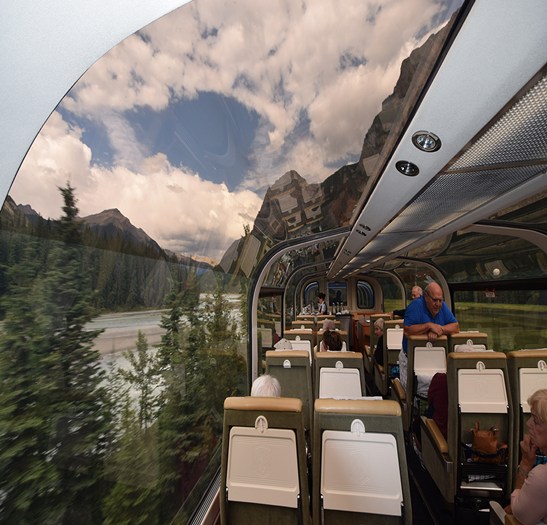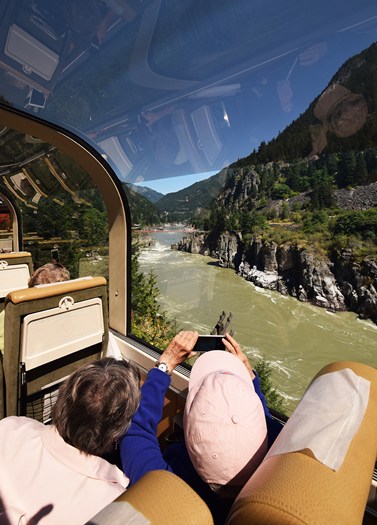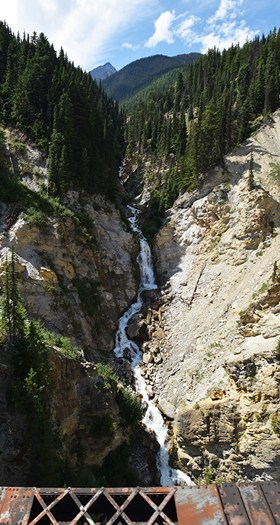VANCOUVER - Coach No. 5 is abuzz with excitement. The occupants have spotted a bald eagle soaring majestically above the bi-level car’s glass dome ceiling and cameras are clicking at a rapid pace. The graceful creature with the piercing eyes and trademark white head and tail seems to be enjoying all the attention and follows our Rocky Mountaineer train until suddenly, and without warning, it drops from the sky like a missile and plucks a large fish out of an emerald green lake with its lethal talons.
Applause fills Coach No. 5 as the Rocky Mountaineer guests salute the bald eagle’s hunting skills.
“Merveilleux,” acclaims the man from France.
“Fabelhaft,” adds the excited German.
“Maravilloso,” an Argentinian grandma chimes in.
“Good onya,” shouts the Australian.
We’re just a few hours into our two-day, 957-kilometre rail journey from Vancouver to Banff aboard the luxurious Rocky Mountaineer and already the 475 passengers appear to be pleased with their investment in this outstanding Canadian product — think luxury cruise line like Silversea or Crystal on rails.
“Oh, and the best is yet to come,” Chan, one of the attentive hosts assigned to Coach No. 5 whispers in my ear.
For the next two days I sit back in the plush surroundings of Coach No. 5, indulge in the 5-Star service offered by Rocky Mountaineer and its exceptional staff and overdose on the eye candy passing outside my window.
As the sleek blue train slowly cuts through the awe-inspiring B.C. bush, I get uninterrupted views of glacial rivers and turquoise lakes, jagged mountains that punch through clouds and seem to touch the sky, pristine pastures where deer and elk run free, rain forests populated with pencil-straight trees, and some surprising desert landscape near Kamloops that looks out of place in these northern climes.
When the train rumbles through small communities, residents drop what they’re doing, rush to the tracks and wave at the strangers passing by on the rolling palace. This prompts a chorus of “Canadians are so nice” comments from the foreigners onboard.
“The people of these small towns are great ambassadors for our country and our train,” says Chan as he offers me an adult beverage and some snacks — expect to exit the train a few pounds heavier thanks to the endless complimentary treats and gourmet meals prepared on board.


Left: The Rocky Mountaineer hosts pamper guests with top-notch service. Right: Chefs like Joy and Ron prepare some memorable meals for guests.
Rocky Mountaineer offers a number of trips that introduces passengers to the natural wonders of B.C. and Alberta. We select the all-inclusive “First Passage to the West” excursion, which starts when we arrive in Vancouver and book into the Hotel Vancouver, Fairmont’s legendary property that Rocky Mountaineer uses to house guests the night before the train departs. The best part of the Rocky Mountaineer experience is that guests are housed overnight in hotels along the route so they don’t miss any of the breathtaking daytime scenery.
Naturally, there’s also different service levels offered — the GoldLeaf Service we sign up for is the most expensive but the most rewarding. GoldLeaf passengers travel in the bi-level cars and get uninterrupted views of their glorious surroundings thanks to the glass ceiling on the upper level. The GoldLeaf cars are also much quieter thanks to the upper deck viewing area.
Complimentary meals are served in the lower level by qualified chefs like Coach No. 5’s Jody and Ron, who create dishes worthy of a high-end Parisian restaurant.
The GoldLeaf cars also come equipped with small elevators so physically challenged passengers can move from level to level with ease. After experiencing other high-end trains like the Belmond Orient Express, I can tell you Rocky Mountaineer is a much better overall product.
Shortly after pulling out of Rocky Mountaineer’s new station in downtown Vancouver — a man in a kilt pipes us aboard — we are served a glass of bubbly and asked to introduce ourselves to the people sitting across from us.
“Part of the Rocky Mountaineer experience is getting to know people from other countries,” David Aboud, the train manager, tells me. Unfortunately, Aboud says, “we don’t get enough Canadians and we’d like to change that.”
Chan then introduces his fellow hosts — Valerie, Michelle, Kate and Robyn, who are exclusive to passengers in Coach No. 5 — and as the skyline of Vancouver fades and the breathtaking Canadian wilderness comes into view, we are summoned to breakfast in the lower level.
Over fluffy blueberry pancakes and cinnamon French toast, we get to know Kate from England and Maggie from Ireland, our tablemates who appear fascinated by what’s passing by our window.
“This is my trip of a lifetime and so far it’s lived up to all my expectations,” says Maggie with a lovely lyrical Irish accent. “We certainly don’t get this glorious scenery in Ireland.”


Above: There is always another great picture around the next bend on the Rocky Mountaineer.
For much of the first day the train cuts through the amazing Fraser Valley and all its natural splendours. When we reach a place called Hell’s Gate, the narrowest part of the Fraser River, Chan informs us 200 million gallons of water rushes through the canyon each minute. The occupants of Coach No. 5 rush to the right side of the car and press their noses up against the glass to get a better view of some kayakers challenging the foamy rapids.
As the train approaches historical landmarks or places of interest, Chan or Valerie explain their significance or importance. When the hosts warn of a possible bear or eagle sighting — they get a warning from the Rocky Mountaineer’s engineer of what’s up ahead — people grab their cameras and rush down the spiral staircase to the open-air viewing platform at the back of Coach No. 5.
“I’ve seen people spend most of the trip on that platform hoping to see some bears and taking pictures of the scenery,” says Valerie, who, like most of the attendants spend about seven months aboard the Rocky Mountaineer each year.
“Thanks to the people I’ve met from all over on this train, I intend to travel the world in this offseason because they’ve encouraged me to visit them,” says Valerie.
The train crosses rusty old iron bridges that have been standing since the early days of Confederation, past mountains with ski runs carved into them, through lands where First Nations people have lived for centuries and past places with some Wild West names — Skuzzy Creek, Jackass Mountain, Cisco Crossing, Rainbow Canyon, Avalanche Alley, Jaws of Death Gorge and Black Canyon Tunnel. Each has a story or a legend attached to them, which Chan and Valerie share with their attentive audience.


Above: A trip on the Rocky Mountaineer is one of the most satisfying journeys you will ever do.
Every so often, the train slows to a stop and waits for a freight train to crawl by — the Rocky Mountaineer shares rail space with both CP and CN trains and must give way to the massive freight trains. Sometimes the wait can be quite long.
“Most freight trains on this line are very long; some three kilometres long, as a matter of fact,” says a wide-eyed Chan.
As the Rocky Mountaineer inches closer to Kamloops, where we overnight in some local hotels, the wilderness landscape suddenly changes — bleached mountains and a semi-arid desert environment replace the lush green we’ve been seeing for most of this journey.
“Welcome to the Canadian desert,” Valerie announces to the bewildered foreigners. “Bet none of you knew we had a desert that resembles Arizona, huh?”
“This country truly is fascinating,” says an American woman named Ruth sitting across from me.
The desert eco-zone that surrounds Kamloops makes this one of Canada’s most unique cities.
“Kamloops is a First Nation word meaning ‘meeting of two waters’ ” says Valerie, who adds, “this is where the North and South Thompson rivers become one.”
Chan and Valerie are up early to welcome us back the next morning to Coach No. 5 and soon the Rocky Mountaineer starts its steep, steady climb through the mighty Rockies in the direction of Banff, the Alberta wonderland that will be our final destination.
Shortly after breakfast, Valerie informs us that we’re about to pass Craigellachie, where, on Nov. 7, 1885, the Last Spike was driven into the ground, marking the completion of the trans-Canada railway (now CP Rail) and linking together all 10 provinces under Confederation. A burst of pride rushes through my veins as the train passes a small monument and museum, which stand as a reminder of this monumental task.
The scenery becomes more dramatic as we climb higher into the Rockies and Chan tells us to prepare for one of the most fascinating parts of our journey. “We’ll soon be entering the fantastic Spiral Tunnels,” he announces.
The Spiral Tunnels were constructed in 1909 to shorten the journey and eliminate a section of the rail line called Big Hill. The tunnels are nothing short of an engineering miracle and as the Rocky Mountaineer snakes its way through this section, we look back and are amazed to see the train’s last car entering the tunnel far below.
When we reach the Continental Divide and Lake Louise, Valerie tells us our journey is quickly coming to an end. “But we have one more surprise for you,” says the charming young woman.
Chefs, Jody and Ron suddenly appear holding trays of freshly baked cookies.
“We want to thank you for coming and we hope you enjoyed your trip with us?” says Jody as the whole coach bursts into appreciative applause.
The Rocky Mountaineer journey exceeds all my expectations and certainly lives up to the company’s promise of providing me with a “life changing experience.” In fact, life doesn’t get much better than Rocky Mountaineer.
Information
Trips offered by Rocky Mountaineer include: First Passage to the West; Journey Through the Clouds; Rainforest to Gold Rush; Coastal Passage. For schedules and information, go to
www.rockymountaineer.com